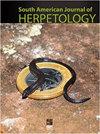Treefrog Diversity in the Neotropics: Phylogenetic Relationships of Scinaxini (Anura: Hylidae: Hylinae)
IF 0.7
4区 生物学
Q4 ZOOLOGY
引用次数: 0
Abstract
Abstract. Scinax is the most species-rich genus of Neotropical treefrogs, with 129 currently recognized species divided between two major clades, the S. catharinae and S. ruber clades. The S. catharinae clade includes 52 species currently placed in the S. perpusillus and S. catharinae groups, whereas the S. ruber clade is composed of 77 species, 13 of which are included in two species groups: the S. rostratus and S. uruguayus groups, with all 64 remaining species being unassigned to any group. Although some studies have addressed the phylogenetic relationships of the genus, its relationships remain poorly understood. To test the monophyly of the genus, its major clades, and the currently recognized species groups, and the relationships within and among them, we performed a total evidence phylogenetic analysis including sequences of five mitochondrial (portions of cytochrome b and cytochrome oxidase c subunit I, and 12S rRNA, 16S rRNA, NADH dehydrogenase subunit 1, plus three intervening tRNAs) and six nuclear genes (portions of chemokine receptor type 4, proopiomelanocortin, seven in absentia homolog 1, recombination activating gene 1, rhodopsin exon 1, and tyrosinase), and 159 phenotypic characters. The dataset included 121 of the 129 known species of Scinax and many unnamed species. Most species are represented by multiple specimens, including topotypic material for approximately 52% of the species. As a result of this analysis, we partition Scinax into three genera. We restrict Scinax to most species of the former S. ruber clade and divide its species among 13 species groups: the S. auratus, S. boesemani, S. cruentomma, S. danae, S. elaeochroa, S. eurydice, S. funereus, S. fuscomarginatus, S. fuscovarius, S. granulatus, S. nasicus, S. rostratus, and S. squalirostris groups; only one species (S. pachycrus) remains unassigned to any group. To eliminate the paraphyly of Scinax, we redefine Julianus—originally erected for the S. uruguayus group—to include the former S. camposseabrai. We recognize Ololygon for the species of the former S. catharinae clade and divide its species among seven species groups: the O. agilis, O. argyreornata, O. belloni, O. cardosoi, O. catharinae, O. feioi, and O. perpusilla groups. All species groups of the three recognized genera of Scinaxini are discussed, diagnosed, characterized—in many cases using phenotypic synapomorphies—and taxonomic comments are provided for many species. Our study further revealed 57 candidate species, an increase of 44.2% of the recognized species in the tribe, highlighting how far we are from fully understanding the diversity of this clade of Neotropical treefrogs.新热带地区树蛙的多样性:树蛙属的系统发育关系(无尾目:树蛙科:树蛙科)
摘要Scinax是新热带树蛙中物种最多的属,目前已知有129种,分为两个主要分支,即S.cathinae和S.ruber分支。卡塔菌属分支包括52个物种,目前被归入佩普西卢和卡塔菌科,而鲁伯菌属分支由77个物种组成,其中13个被归入两个物种组:罗斯特拉图斯和乌拉圭菌组,其余64个物种均未被归入任何一个组。尽管一些研究已经解决了该属的系统发育关系,但对其关系的了解仍然很少。为了测试该属的单系性、主要分支和目前公认的物种群,以及它们之间的关系,我们进行了全面的系统发育分析,包括五个线粒体(部分细胞色素b和细胞色素氧化酶c亚基I,12S rRNA,16S rRNA和NADH脱氢酶亚基1,加上三个中间tRNA)和六个核基因的序列(部分趋化因子受体4型、阿片前胶原、7个缺失同源物1、重组激活基因1、视紫红质外显子1和酪氨酸酶),以及159个表型特征。该数据集包括129种已知的Scinax物种中的121种和许多未命名的物种。大多数物种由多个标本代表,包括约52%的物种的地形型材料。根据这一分析,我们将Scinax分为三个属。我们将Scinax限制在前红腹蛛分支的大多数物种中,并将其物种分为13个物种组:auratus、S.boesemani、S.cruentomma、S.danae、S.elaeochroa、S.eurydice、S.funereus、S.fuscomarginatus、S.fuscovarius、S.granteus、S.nasicus、S.rostratus和S.squarirostris组;只有一个物种(S.pachycrus)未被分配到任何类群。为了消除Scinax的副作用,我们重新定义了最初为乌拉圭人建立的Julianus,将前camposseabrai包括在内。我们将Ololygon识别为前S.cathinae分支的物种,并将其物种分为七个物种群:O.agilis、O.argyrornata、O.belloni、O.cardosoi、O.cathinae、O.feoi和O.perpusila群。对三个公认的Scinaxini属的所有物种群进行了讨论、诊断和表征——在许多情况下使用表型突触形态——并为许多物种提供了分类学评论。我们的研究进一步揭示了57个候选物种,比部落中公认的物种增加了44.2%,突显出我们离充分了解新热带树蛙分支的多样性还有多远。
本文章由计算机程序翻译,如有差异,请以英文原文为准。
求助全文
约1分钟内获得全文
求助全文
来源期刊
CiteScore
1.50
自引率
0.00%
发文量
10
期刊介绍:
The South American Journal of Herpetology (SAJH) is an international journal published by the Brazilian Society of Herpetology that aims to provide an effective medium of communication for the international herpetological community. SAJH publishes peer-reviewed original contributions on all subjects related to the biology of amphibians and reptiles, including descriptive, comparative, inferential, and experimental studies and taxa from anywhere in the world, as well as theoretical studies that explore principles and methods.

 求助内容:
求助内容: 应助结果提醒方式:
应助结果提醒方式:


